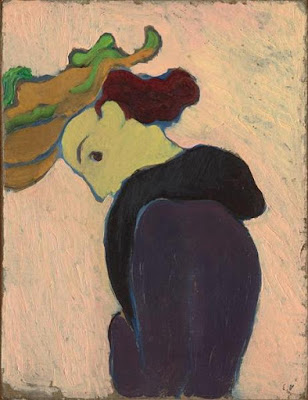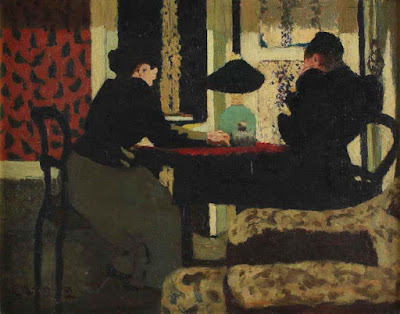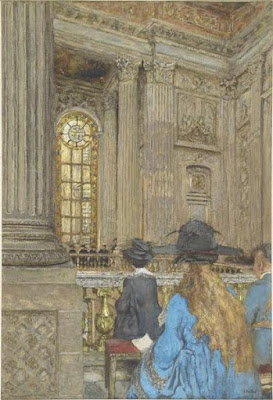 |
| Édouard Vuillard Woman in Blue ca. 1925-30 pastel on paper Musée du Louvre |
 |
| Édouard Vuillard The Nurse 1896 oil on cardboard, mounted on panel Musée Picasso, Paris |
 |
| Édouard Vuillard Woman in Profile ca. 1891 oil on cardboard Musée d'Orsay, Paris |
 |
| Édouard Vuillard Vase of Flowers 1904 oil on cardboard Musée d'Orsay, Paris |
 |
| Édouard Vuillard La Ravadeuse 1891 oil on cardboard Musée d'Orsay, Paris |
 |
| Édouard Vuillard Portrait of couturière Jeanne Lanvin 1935 oil on canvas Musée d'Orsay, Paris |
 |
| Édouard Vuillard Portrait of La comtesse Jean de Polignac (daughter of Jeanne Lanvin) ca. 1930 oil on canvas Musée d'Orsay, Paris |
"La comtesse Jean de Polignac, originally known as Marguerite di Pietro, was the only child of Jeanne Lanvin. And La Mère Lanvin doted on her daughter. She started creating charming and beautifully made clothing for her daughter, then opened a children's store [in Paris], and eventually began designing for both mothers and daughters. In fact, such was Lanvin's devotion to her daughter that the Lanvin label is a Paul Iribe drawing of a mother and daughter holding hands. After marriage to comte Jean de Polignac, Marguerite di Pietro became Marie-Blanche de Polignac, inhabiting an apartment [glimpsed above] in rue Barbet-de-Jouy and staging musical soirées on Sundays, when she sang opera for her guests."
 |
| Édouard Vuillard Beneath the Trees ca. 1905-1907 tempera and pastel on paper, mounted on canvas Musée des Augustins de Toulouse |
 |
| Édouard Vuillard Beneath the Lamp 1892 oil on canvas Musée de l'Annonciade, Saint-Tropez |
"Vuillard's paintings, which are surprisingly accurate representations of late nineteenth-century interiors, express something about the duality of late nineteenth-century women's lives. For while his interiors exude a sense of coziness and intimacy, they also have a claustrophobic quality – conveying the message that a woman's role as a mother and homemaker can be experienced as restricting."
– Petra ten-Doesschate Chu, Nineteenth-Century European Art (Hoboken, N.J: Prentice-Hall, 2003)
"Like his friend Mallarmé, who wanted to dissolve the materiality of objects through the alchemy of poetry, Vuillard sought comparable feats of magic with the images of ordinary things, without, however, violating a sense of continuous and loving contact with a Parisian middle-class milieu of comfort and sweet domesticity."
– Robert Rosenblum, 19th-Century Art (New York: Abrams, 1984)
 |
| Édouard Vuillard Café in the Bois de Boulogne ca. 1897-98 distemper on paper Musée des Beaux-Arts et d'Archéologie, Besançon |
 |
| Édouard Vuillard Bouquet of Flowers ca. 1900 oil on cardboard Palais des Beaux-Arts de Lille |
 |
| Édouard Vuillard Woman in a Café ca. 1890-1900 tempera, gouache and watercolor on paper Musée du Louvre |
 |
| Édouard Vuillard The Fitting 1892 oil on panel Musée des Beaux-Arts de Saint-Denis, Reims |
 |
| Édouard Vuillard Chapel at Versailles ca. 1914-28 tempera on canvas Musée d'Orsay, Paris |
 |
| Édouard Vuillard L'Allée 1900 tempera on canvas Musée d'Orsay, Paris |